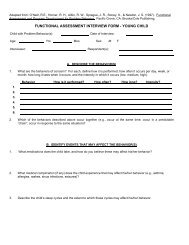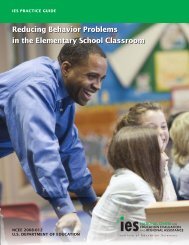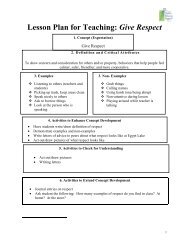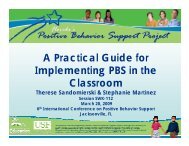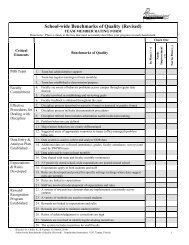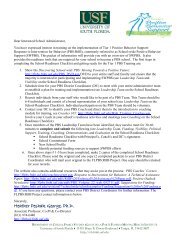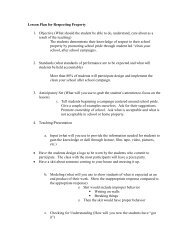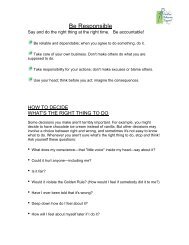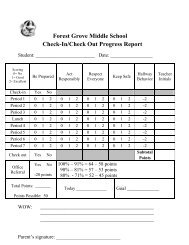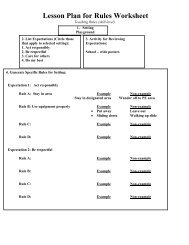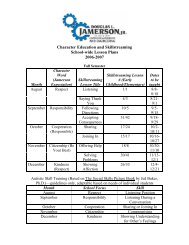Georgia PBS Interventions - Florida's Positive Behavior Support ...
Georgia PBS Interventions - Florida's Positive Behavior Support ...
Georgia PBS Interventions - Florida's Positive Behavior Support ...
- No tags were found...
Create successful ePaper yourself
Turn your PDF publications into a flip-book with our unique Google optimized e-Paper software.
School age children -hang upside down from the monkey bars, roll down a grassy or snowy hill (goodpro-prioceptive input as well), ride a roller coaster, and use swings.Teenagers and Adults- swing on a hammock, use playground swings or merry-go-round (you're never tooold!), do cartwheels and dance (also provides pro-prioceptive input).TactileTactile input is the sense of touch and includes texture, temperature, pressure, and more. Don'tforget that the tactile system includes not only the skin covering your body but also inner skin liningssuch as inside the mouth.Toddlers and Preschoolers -Let them drink plain seltzer or carbonated mineral water to experiencebubbles in her mouth (you can flavor with lemon, lime, etc.). Play with foamy soap or shaving cream, addsand for extra texture, use finger-paint, play with glitter glue, mix cookie dough and cake batter, andso on. Let your child use the playground sandbox or create your own at home, filling a bin with drybeans and rice or other materials. Use clay such as Play-Doh (the classic Play-Doh Fun Factory providesexcellent pro-prioceptive input as well). Don't force a child who is unwilling to touch all these "yucky"substances. Let her use a paintbrush, stick, or even a toy for cautious exploration.School age children eat frozen foods (popsicles, frozen fruit or vegetables), dress up in fun costumesto get used to the feel of unfamiliar clothing, garden and repot indoor plants, play with make-up andface painting.Teenagers and Adults sculpt, sew, weave, crochet or knit, create a scrapbook (lots of pasting andworking with different textures), use sandpaper to smooth a woodworking project, take a very cold orhot shower or bath.AuditoryAuditory input is what we hear and is neuroanatomically connected with the vestibular sense. Inaddition to listening to various types of music, both recorded and live, here are some ways to getcalming and organizing auditory input.Get out in nature and listen. Go to the beach or sit still and listen to a thunderstorm or windstorm. Ifyou hear birds singing, try to identify what direction a given bird is calling from.Listen to natural sounds recordings such as a rainstorm, waves crashing against the beach, or birds inthe forest. Sometimes natural sound recordings also feature light instrumentation with flutes,keyboards, etc. Play a listening game: you and your child sit very quietly and try to identify the soundsyou hear (traffic, the hum of the refrigerator, a door shutting, etc.).Listen to Hemi Sync (R) recordings of sounds and music specially engineered to promote calming, focus,energy, or creativity. (Available from www.discoverytoolsandworkshops.com).Encourage your child to play a musical instrument. For a child with auditory sensitivity, controlling thesounds she hears can be especially helpful. If your child is fearful of loud noises, let him control thevolume on the stereo, exploring soft vs. loud music.Get a white noise machine, tabletop rocks-and-water fountain, or aquarium.<strong>Positive</strong> <strong>Interventions</strong> and Effective Strategies Riffel -© 2005 - 85 -




